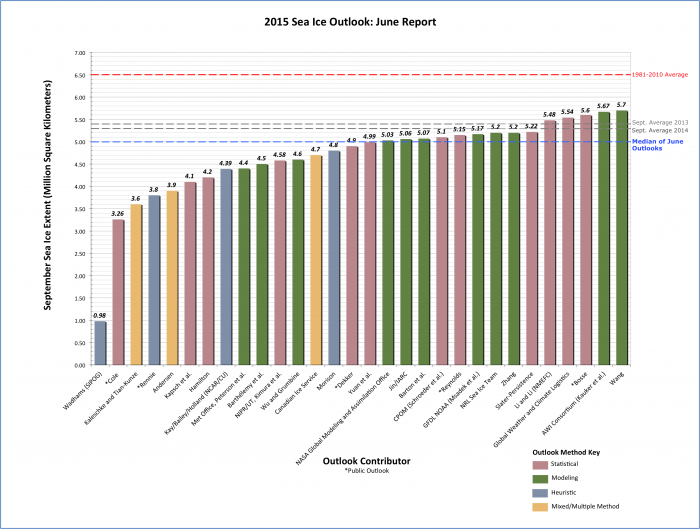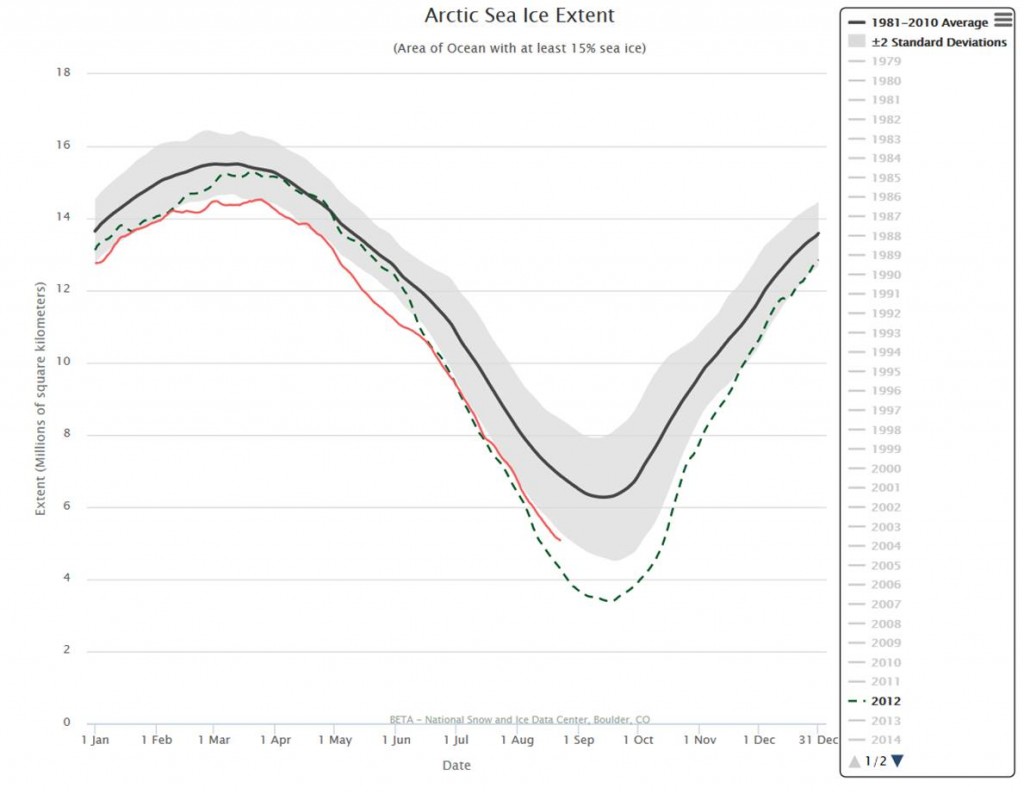Arctic sea ice more stable than thought: once agin likely no new record melt
By Dr. Sebastian Lüning and Prof. Fritz Vahrenholt
(German text translated by P Gosselin)
On June 14, 2016, Swiss flagship daily Neue Zürcher Zeitung (NZZ) reported on an imminent record ice melt in the Arctic:
Record ice melt in the Arctic: ‘heat wave ‘ over Greenland
Arctic sea ice is headed for a new record summer minimum. The disappearance of the ice sheet can initiate decisive climatic events. Arctic sea ice is currently melting faster than the record 2012 year. According to data from the Snow and Ice Data Center (NSIDC) the polar ice cover this May (completely frozen or with a sea ice concentration of at least 15 percent) was about 580,000 square kilometers less than 2004; that corresponds to the size of France. The total sea ice area is still at 12 million aquare kilometers, or about one and half times the area of Australia. A new minimum is forseeable.”
Continue reading at the Neuen Zürcher Zeitung.
Was the alarmism justified? Looking at the official data from the NSIDC (Figure 1), the dotted green line depicts the sea ice extent for the record melt year 2012, the red line depicts 2016. In the first half of this year the melt rate was in fact at a record pace. In July, however, the melt slowed down. The fact is: Since July 2016 there is a lot more sea ice than at the same time in 2012. In mid September, when the ice typically reaches its minimum, we will have the final result.
Figure 1: Arctic sea ice extent. Source: NSIDC
On August 19, 2016, NASA issued a press release that foresaw the failure of reaching a new record minimum:
NASA Monitors the ‘New Normal’ of Sea Ice
This year’s melt season in the Arctic Ocean and surrounding seas started with a bang, with a record low maximum extent in March and relatively rapid ice loss through May. The melt slowed down in June, however, making it highly unlikely that this year’s summertime sea ice minimum extent will set a new record. “Even when it’s likely that we won’t have a record low, the sea ice is not showing any kind of recovery. It’s still in a continued decline over the long term,” said Walt Meier, a sea ice scientist at NASA’s Goddard Space Flight Center in Greenbelt, Maryland. “It’s just not going to be as extreme as other years because the weather conditions in the Arctic were not as extreme as in other years.” “A decade ago, this year’s sea ice extent would have set a new record low and by a fair amount. Now, we’re kind of used to these low levels of sea ice – it’s the new normal.”
This year’s sea ice cover of the Barents and Kara seas north of Russia opened up early, in April, exposing the surface ocean waters to the energy from the sun weeks ahead of schedule. By May 31, the extent of the Arctic sea ice cover was comparable to end-of-June average levels. But the Arctic weather changed in June and slowed the sea ice loss. A persistent area of low atmospheric pressure, accompanied by cloudiness, winds that dispersed ice and lower-than-average temperatures, didn’t favor melt.
The rate of ice loss picked up again during the first two weeks of August, and is now greater than average for this time of the year. A strong cyclone is moving through the Arctic, similar to one that occurred in early August 2012. Four years ago, the storm caused an accelerated loss of ice during a period when the decline in sea ice is normally slowing because the sun is setting in the Arctic. However, the current storm doesn’t appear to be as strong as the 2012 cyclone and ice conditions are less vulnerable than four years ago, Meier said.”
But curiously, the British daily The Guardian just a day earlier (18 August 2016) wrote that the Arctic sea ice was caught in the midst of a “death spiral”:
Time to listen to the ice scientists about the Arctic death spiral
The Arctic’s ice is disappearing. We must reduce emissions, fast, or the human castastrophe predicted by ocean scientist Peter Wadhams will become reality […] Because Wadhams says what other scientists will not, he has been widely slandered, attacked and vilified by denialists and politicians who have advised caution or non-action. But now he returns their fire, exhorting people to counter what he calls “the sewage flow of lies and deceit” emitted by the deniers. Above all, he says, people who study climate change should speak up and be prepared to risk the blighting of their careers and absence of honours. But he joins other climate researchers to cross lines that the public may still find unacceptable. He wants global action to find new ways to remove carbon from the atmosphere, and is not afraid of nuclear power – both of which answers can be swallowed – but he also argues for a colossal, global research programme in geo- engineering. […]”
It certainly is a strange “death spiral” when there hasn’t been an increased melting in 4 years.
Also the reminder that we should be listening much more closely to sea ice scientist Peter Wadhams also sounds comical, especially when one closely considers the earlier forecasting performance of the climate-alarmism-prone scientist. In the following chart we find 30 different estimates for last year’s Arctic minimum issued before the ice melt season began (Figure 2).

Figure 2: Estimate forecast for the 2015 Arctic sea ice minimum from 30 different scientific groups. Source: SIPN.
Result: By a huge margin Peter Wadhams comes in as a straggler in last place, miles away from the real value of 4.5 million square kilometers. How embarassing.
And we’re supposed to be listening more closely to Wadhams?
Scientific colleague Ed Hawkins of the University of Reading was outraged about how the Guardian could hype up this scientific fringe position. At Twitter he expressed his irritation:
It doesn’t surprise us that science fringe Wadhams gladly cooperates with the no lesser extremist Potsdam Institute for Climate Impact Research (PIK). Among others, Wadhams also appears in a publication together with Anders Levermann, who belongs to the hard core of the PIK climate alarmism group.







Sunshinehours shows the current Arctic sea ice level as about 940,000 km² more than 2012 at the same day.
https://sunshinehours.net/2016/08/26/arctic-sea-ice-extent-940000-sq-km-higher-than-2012-day-238-2016/
“Scientific colleague Ed Hawkins of the University of Reading was outraged about how the Guardian could hype up this scientific fringe position.”
The government-scientific/medial/political complex has a 3-card-Monte-pack-hunting strategy: The government scientists take turns in making outrageous predictions. The illiterate journa(commu)nists propagate the scariest one, in huge letters, calling their critics anti-science. The politicians then call this agitprop “public opinion” and impose punitive taxes – and hand over some of the proceeds to the government scientists and the journalists. (The Guardian sells half its printed circulation directly to the BBC which claims they need to have a Guardian in every office daily so THEIR illiterates stay “informed”.)
After all this has happened and the prediction fails, the 95% of the government scientists with the less exciting predictions say, see, we’re honest scientists.
No one with an IQ > 3 pays any attention to The Guardian
so no worries.
Lots of folks have predicted the end of the world. Peter W. is just the most recent and, as yet, not the looniest. Give him time.
Here are 11 others (#1 and towards the end are recent).
http://news.nationalgeographic.com/news/2011/05/pictures/110520-may-21-doomsday-harold-camping-judgement-day-rapture-end-of-the-world/
I just love Peter wacky´s dire predictions.
He´s actually doing our side of the argument a very big favour.
Maybe not intended, but even his fellow “scientists” calls him loony
The Arctic sea ice WAS heavily affected by the El Nino in the early part of the year…
.. heck the one really big “hot spot” was in northern Russia.
The FACT that it has refused to melt anywhere near the amount of 2012 shows that the melt season is nowhere near as “extreme” as the Arctic sea ice worrier “predict” through their gamed models.
Next year, it should be totally hilarious to watch them as the Arctic sea ice level starts to climb towards the 1981-2010 average in response to the NATURAL cycle of the AMO and the rather quite Sun. 🙂
[…] – See more at: notrickszone.com […]